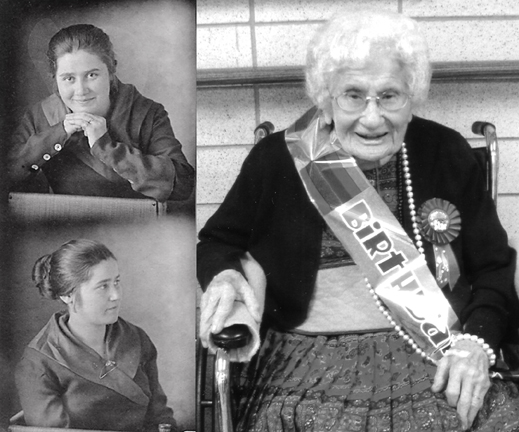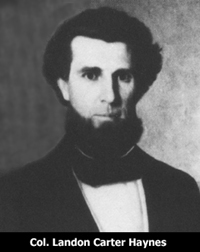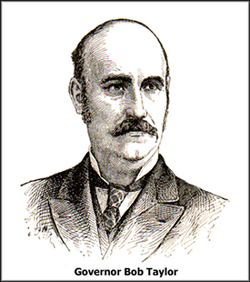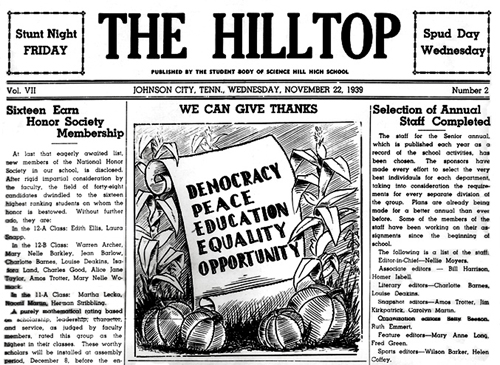Besse Brown Cooper, former area resident, celebrated her 113th birthday on August 26, making her a super-centenarian (someone over 110) and currently #8 (as of Mar. 3) on the list of the oldest living people in the world (www.grg.org/Adams/E.HTM).

Her son, Sidney, and daughter, Angie Tharp, shared her story for this column. Besse, a daughter of Richard Brown and Angie Berry Brown, was born in Sullivan County on Aug. 26, 1896, and lived on the banks of the Watauga River for several years. She and her siblings enjoyed the benefits of living near and playing in the river.
According to Sidney: “In November 1900 while Mother was four years old, her aunt and uncle convinced her parents to move to Arkansas, known as the ‘Land of Opportunity.’ The two families built a large houseboat alongside the river for the journey. It was fabricated upside down, turned over and then placed on the river. This attracted a lot of attention from neighbors and friends.
“Their journey took them down the Watauga River and into the Tennessee River. They had a rudder and guided the boat with a big pole. They docked at night and traveled by day. Besse remembered being tied around the waist to keep her from falling off the boat. One night, the weather was so cold that the river froze delaying them for three days.”
When the two families reached Chattanooga, they became stuck on a sandbar at low tide causing Mr. Brown to go into town to get assistance. He was advised against going to Arkansas because of a high number of Yellow Fever cases there. They abandoned their journey, sold the houseboat and rented a house for about a year while Mr. Brown worked in the city as a carpenter.
They decided to return to the Johnson City area. In 1906, the Brown family moved to the Boones Creek community where they built a two-story wood house on 15 acres of land on a hill along what is now called Brown Road. Besse attended Boones Creek School, graduating in 1913.
Miss Brown enrolled at East Tennessee Normal School (which had opened just two years prior). She rode the CC&O train between Gray Station and Johnson City on weekends and boarded with her aunt in Johnson City during the week. She commuted to and from the Normal School on a trolley. She greatly admired school president, Sidney J. Gilbreath, later naming a son after him.
After earning a teacher’s certificate, Besse taught at a school in Tiger Valley, TN, between Hampton and Roan Mountain, and rode the Tweetsie narrow gauge railroad to and from there each weekend. When she exited the train, she had to walk and carry a suitcase another five miles to her boarding house in all kinds of weather. Her next jobs were at Cog Hill School at Etowah, TN where she taught about a year and at Piney Flats.
Besse moved to Georgia in 1918 where she met and married Luther H. Cooper in 1922. This union bore four children: Angie Tharp; L.H. Cooper, Jr.; Sidney Cooper; and Nancy Cooper Morgan.
Sidney attributes his mother’s long life to her being an outdoor person who loved working in her yard and garden, not worrying about things and eating right. While in Boones Creek, she was a member of Boones Creek Baptist Church. Several family members are buried in the church cemetery.
Besse’s four brothers: Thomas Cecil Brown (BC storeowner), John Ralph Brown, Edward King Brown (butcher at Copp’s Grocery on Millard Street in JC) and Richard E. Brown) and three sisters: Besse Berry Brown Cooper, Mary Lee Brown (long time BC schoolteacher) and Urcel Brown (Morton Brothers meat producers) were residents in the Boone’s Creek area.
The city of Monroe, GA honored the super-centenarian by proclaiming Aug. 26, 2009 as “Besse Cooper Day.”
NOTE: Besse Cooper passed away peacefully on Tuesday, December 4, 2012 at the age of 116. I wish to thank her son, Sidney, for the honor of allowing me to write her story for the Johnson City Press.






